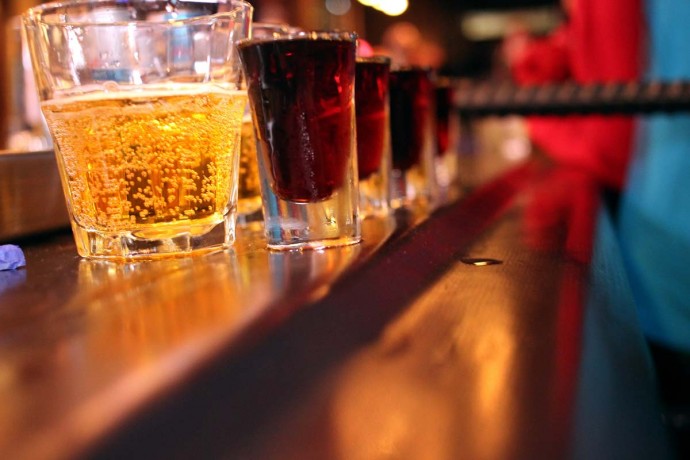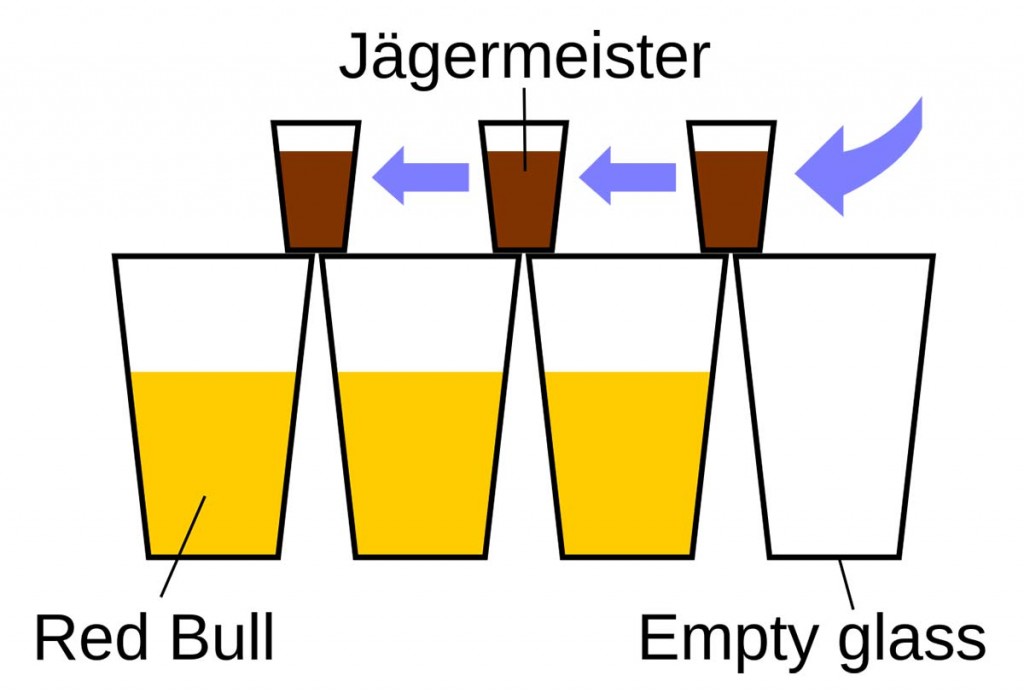It may sound crazy, but Jägermeister really wishes you hadn’t discovered the Jägerbomb. Sure, the drink may be responsible for skyrocketing sales of the German herbal liqueur over the last ten years—and they’re certainly not complaining about that—but uniquely among the (admittedly limited) family of Jägermeister drinks, it’s causing the brand something of an image problem.
What is Jägermeister, Anyway?
First, it’ll probably be helpful to have some background on what actually goes into the recently-anointed party king that is the Jägerbomb. The recipe itself is pretty straightforward: you just fill an Old-Fashioned glass partway with Red Bull, then drop a shot glass full of Jägermeister into it and drink the whole thing down in one gulp.
There’s even this hilariously straight-faced schematic from Wikipedia, depicting a “Jäger-train,” in which several Jägermeister shots are lined up on the edges of their Red Bull glasses, and each one knocks the other in like a chain of dominoes.
As for what goes into the Jägermeister itself—well, that’s a different story. Officially the complete ingredient list is a secret, as it is with most complex herbal liqueurs, but we know that it contains 56 varieties of herbs, fruits, spices, and roots. Prominent among them are saffron, ginger, licorice, citrus peel, ginseng, juniper berries, and all kinds of other pretty standard stuff.
And to address the elephant-sized rumor in the room, no, it does not contain elk or deer blood. Seriously, have you ever tried to work with that stuff? It just wouldn’t hold up.
After those herbs and spices are steeped in a neutral spirit and water for a few days, the resulting infusion is filtered and aged in oak barrels for no less than one year. It’s then filtered one more time, sweetened with sugar and caramel, and bottled.
The final product is similar to a lot of other dark European liqueurs, though Jägermeister tends to be a bit on the sweeter side than something like Fernet, Hungarian Unicum, or even Bénédictine. It’s still a bit of a polarizing flavor, but it’s generally considered more on the entry-level of the herbal liqueur market, and has racked up some pretty stellar reviews regardless.
So, What’s Wrong with the Jägerbomb?
Well, there’s not necessarily anything wrong with it per se. It’s a totally fine, if somewhat unsubtle recipe, and having one or two isn’t going to kill you. The problem, as far as Jägermeister and public health officials are concerned, arises from just how many Jägerbombs people seem to be drinking in one sitting.
Due in part to the culture of excess surrounding the drink, which is most popular among club-going twenty-somethings, news stories of people being hospitalized after knocking back more than ten at a time have been cropping up over the last several years.
Now, forgetting about the alcohol content for a moment, that amount of caffeine alone (roughly 400mg, assuming about half a standard can per drink) is already brushing up against the upper edge of safe levels recommended by the American Medical Association. This can cause all kinds of unpleasant side effects, chief among them being anxiety, nausea, and vomiting, but that’s not the primary issue.
As a stimulant, caffeine tends to mask the depressant effects of alcohol, making people significantly more likely to keep drinking way more than they should—they simply don’t feel as drunk. According to the CDC, they’re also a lot more likely to drive under the influence or do other stupid stuff that’s less common when consuming standard Jägermeister drinks, like, you know, shots.
A Craftier Jägermeister
You can see, then, why Jägermeister isn’t exactly thrilled that their brand has recently been associated with that side of drinking culture. Prior to the early 2000s, their sales weren’t necessarily stellar, but they were comfortable with their place among the relatively obscure liqueurs on the back bar.
Now, they’re trying to shift the narrative. The brand’s latest campaign, “It Runs Deep,” attempts to paint Jägermeister as a more sophisticated digestif, tapping into the zeitgeist of the all-important craft spirits movement. As the fad of the Jägerbomb begins to ebb, they want to ensure that their product won’t join the likes of Galliano in the realm of forgotten decadal booze.
Since there aren’t quite as many well-known Jägermeister drinks on the market, though, it’ll likely be an uphill battle. Most of their recent marketing has been focused on serving it in elegant, chilled shot glasses, but when your audience contains a large subset of fist-pumping party-goers, that refinement might not have huge appeal.
The sad part is that Jägermeister is actually a very well-regarded liqueur in the world of craft drinking, garnering 91 points from Wine Enthusiast and an impressive 96-point review from the Beverage Testing Institute. Maybe that will be enough to support it after the bottom falls out of the Jägerbomb market, and we certainly hope that it is.
And if not, well, at least this drink has thoroughly made its mark on a generation—even if it’s not the one they’d hoped.
Photo: RyAwesome via Flickr




